Sauraha, Nepal
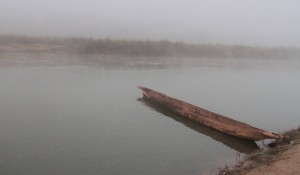
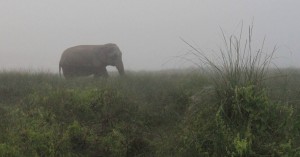
I woke up today at roughly 05:30, dressed in appropriate safari clothes, grabbed my camel-back and camera, and met the Canadian man outside at 06:10. We then walked to the cafe that the group of guides appear to all operate out of and the Canadian man grabbed his packaged lunch to take with him on today’s walk. We had met our guides (two, one experienced point man and a rear man who spoke better English and could communicate with us) at the cafe and waited for the Nepalese Army guard to arrive at the entrance of Chitwan National Park to allow visitors in; once he arrived, we crossed through, and then took a dugout canoe across the Rapti River (the northern boundary of the actual park – at least from where we were); we then exited out on to the river’s southern shore and began our walk in the park. Immediately we watched an elephant cross in front of our path; we were told by one of our guides that this elephant was between fifty and sixty years old and that it was a retired government employee (the private elephants are worked until death).
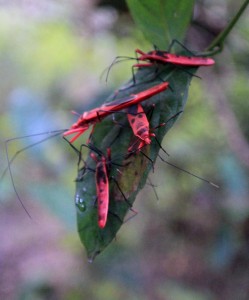
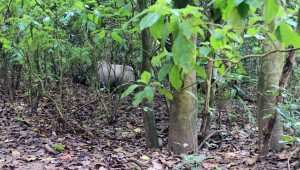
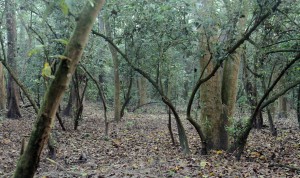
We then walked in to the subtropical broad-leaf forest, trying to remain as silent as the crackle of dead leaves and twigs below the soles of our feet would allow. Our guides pointed out the abundant red cotton bugs (from the Pyrrhocoridae family) to us, which were to be found all over the forest (i.e. on the back of leaves, on the tree trunk, and on the ground). After about twenty minutes of walking, we stumbled upon a giant, sleeping, one-horned rhinoceros; our guides told us to get behind a tree trunk for protection and then they had the Canadian man and myself climb up separate short trees (we were not far up and still well within range of the giant beast’s one horn, but was I afraid of this gigantic rhinoceros? “Imposerous!” – I just wanted to get some decent photos of him); the guides then threw sticks at him and banged the ground with their hiking poles, but the rhinoceros was not intimidated, he didn’t care, and he would not budge; at this point the guides realized he was a very strong male and they suggested we quickly leave in case the beast did decide to get up and aggressively defend his domain.
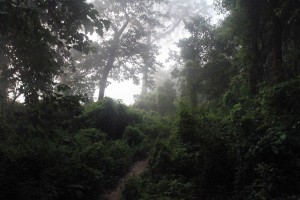
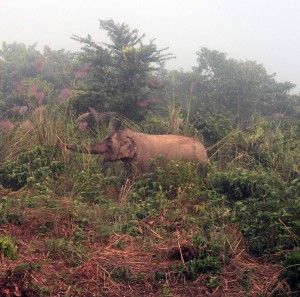
Next we came across some spotted deep, as well as a barking deer; all of which fled upon noticing us (these are not like the deer in the United States National Parks, who are several generations removed from those forefathers of theirs that were hunted and who have now grown accustomed to us – this park was only established in 1973). We then exited the forest and emerged in to the grasslands, where we spotted some peacocks (they can indeed fly for short distances and to small heights) and other birds, smelled a tiger’s marked territory, and watched that lovable retired government pachyderm feed itself on the tall grass (our guide told us that there is currently only one retired elephant in the park, so each time we spotted an elephant in Chitwan, it was the same one, for we did not witness any wild elephants on our safari today – perhaps a spoiler alert should’ve preceded that last sentence). We then reentered the forest, saw some monkeys up in the trees, holes dug by sloth bears to get at roots to eat, and leopard prints left in the soil.
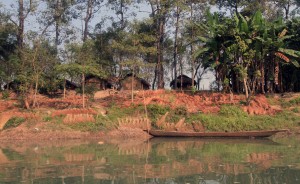
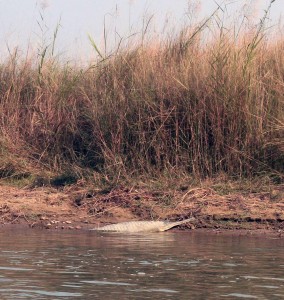
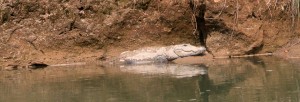
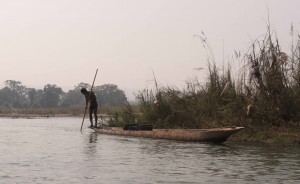
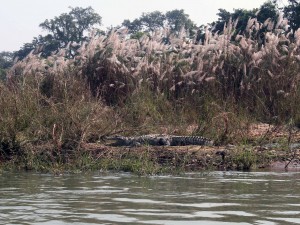
We then exited the forest again, walked back to the river, took a dugout canoe across to Sauraha, and walked back to the cafe to wait for our canoe to arrive (the one that was hired to transport us ten kilometers down the Rapti River). After waiting at the cafe for a while (where I had a Carlsberg for breakfast), we walked to the beach along the river’s bank and waited there for some more time. Finally, a canoe arrived to transport us – our canoe trip was scheduled to begin at 09:00, but did not actually begin until 09:58. We went a short distance down the river, switched to a lighter canoe, and then finally continued on. Finally. During the canoe trip, we saw many mugger crocodiles and some gharials (severely endangered crocodiles with long and thin snouts), as well as a wide variety of birds – kingfishers, storks, ducks, ospreys, ibises, and a number of others I cannot recollect; we also saw many holes along the eroded sandy bank where a number of small birds have dug-in nests. I did see the tail end of a mongoose as he ran back inside the vegetation for concealment. After ninety minutes, our “two hour” canoe trip ended. We pulled up along the southern shore, exited the craft, and walked up to the surrounding grasslands.
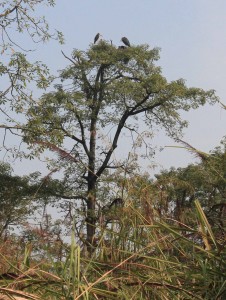
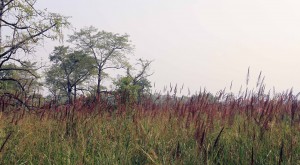
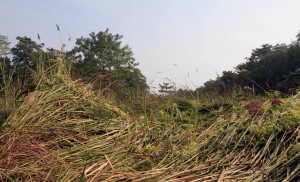
Immediately upon entering the grasslands, we came across a long, freshly-shed, snake skin (almost two meters) and took photos of it; also, our guides pointed out sloth bear claw marks on one of the trees we passed by. We then walked through the grasslands, on a dirt road, having to step aside for several passing jeep safaris (ugh). The grass in the park was extremely tall, standing at about six meters high; so the chance of seeing any mammals in the area were extremely low. We stopped for lunch at a wooden watchtower that was falling apart and kept a look out while we chowed down (I just had coconut cookies) – I did see a chipmunk. After lunch, our guides pointed out an osprey nest and we watched one of the adults feed its young. We then continued on the dirt road and came back to the subtropical broad-leaf forest (or at least a mix between the grasslands and forest). Our guides pointed out some tiger claw marks on the ground and a log while in the forest; we then entered a small patch of grassland where the more experienced of our two guides sensed a rhinoceros in the grass (we were told that after the sun comes out, the rhinos like to leave the forest and enter in to the grasslands to cool down); we slowly walked by and then entered the edge of the forest; we remained quiet and took cover behind a tree while our experienced guide assessed the situation; the rhinoceros then let off a couple of loud grunts while we waited; our guides then decided to lead us to a small lake by the river and see if any pachyderms were drinking the water, as well as to wait to see if the nearby rhinoceros would come out to have some cool, refreshing water.
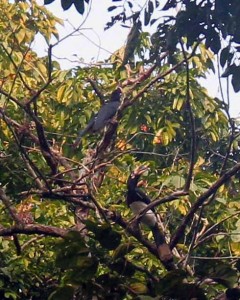
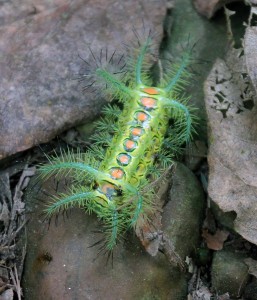
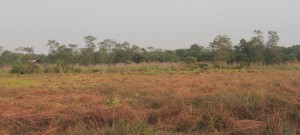
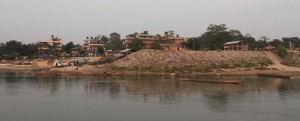
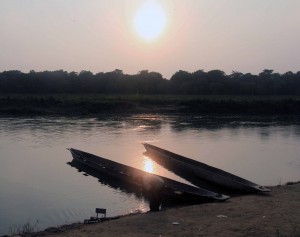

We hung out by the river for a while before deciding to circle around where the rhinoceros was hanging out. So we walked through the forests, came across many more fleeting deer (to be more precise: spotted and barking deer) and several oriental pied hornbills. The rhinoceros never did get his lazy ass up out of the grass, so we didn’t see it and eventually it came time to continue on through the park. We joined up with the dirt road again and took that back to the park entrance (ugh). We another monkey and came across a very exotic looking and poisonous caterpillar. On the way we also passed by another section of grassland with a watchtower, but figured it would be a waste of time to wait up there and try to spot mammals. We then came back to the river where some domesticated water buffalo were grazing and where that retired elephant now was, playing with a log in the river. We walked to the shore and took a dugout canoe across to the other side, finishing our jungle walk just after 16:00. We thanked our guides and tipped them, before the Canadian man and I walked to a nearby rooftop restaurant to enjoy some much needed cold beers. As the time passed and evening turned to night, we watched the sun set, snacked on popcorn and fried potato cheese balls, watched the privately-owned elephant slaves return to their stables to be chained up for the night, and eventually had dinner (I had an “eggplant and mushroom lasagna” that ended up being sliced up pasta stirred together with tomato sauce, cheese, and some hard, dried peels of an unidentifiable vegetable; it was not lasagna, it did not have mushrooms, and I don’t think it had eggplants (unless those skin peels were eggplant skins) – in other words, “it sucked”). After dinner, we walked back to the hotel we were staying at and I snacked on some more coconut cookies and beer while listening to Creedence Clearwater Revival and Pink Floyd before going to sleep.
